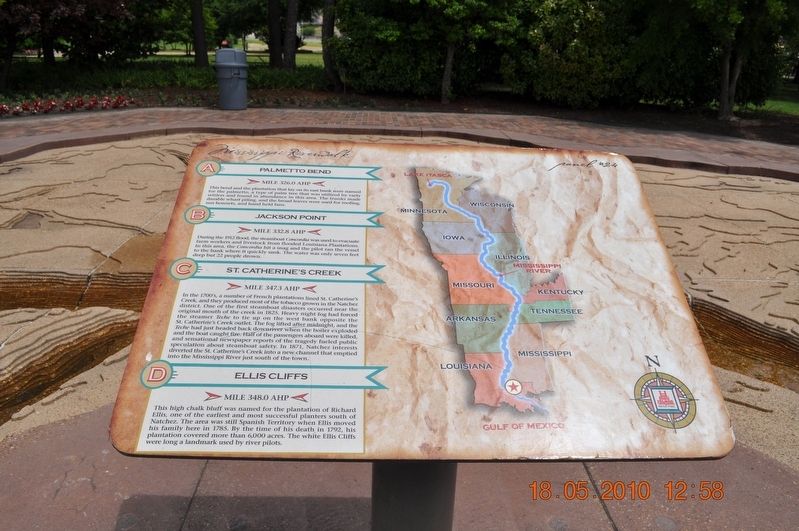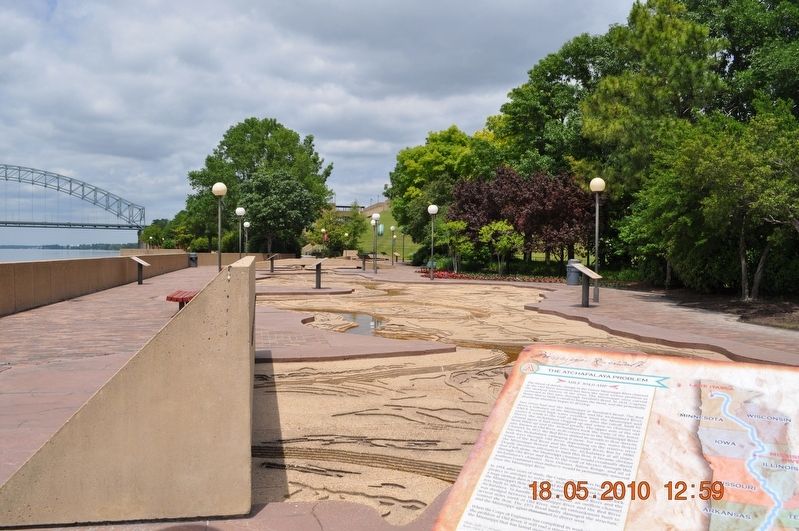Memphis in Shelby County, Tennessee — The American South (East South Central)
Palmetto Bend/Jackson Point/St. Catherine’s Creek/Ellis Cliffs
Panel # 24
Inscription.
A.Palmetto Bend
Mile 326.0 AHP
This bend and the plantation that lay on its bank were named for the Palmetto, a type of palm tree that was utilized by early settlers and found in abundance in this area. The trunks made durable wharf piling, and the broad leaves were used for roofing, sun bonnets, and hand held fans.
B. Jackson Point
Mile 332.8 AHP
During the 1912 flood, the steamboat Concordia was used to evacuate farm workers and livestock from flooded Louisiana Plantations. In this area, the Concordia hit a snag and the pilot ran the vessel to the bank where it quickly sank. The water was only seven feet deep but 22 people drowned.
C. St. Catherine’s Creek
Mile 347.3 AHP
In the 1700s, a number of French plantation lined St. Catherine’s Creek, and they produced most of the tobacco grown in the Natchez district. One of the first steamboat disasters occurred near the original mouth of the creek in 1825. Heavy night fog had forced the steamer Teche to tie up on the west bank opposite the St. Catherine’s Creek outlet. The fog lifted after midnight, and the Teche had just headed back downriver when the boiler exploded and the boat caught fire. Half of the passenger abroad were killed, and sensational newspaper reports of the tragedy fueled public speculation about steamboat safety. In 1871, Natchez interests diverted the St. Cathrine’s Creek into a new channel that emptied into the Mississippi River just south of the town.
D. Ellis Cliffs
Mile 348.0 AHP
This high chalk bluff was named for the plantation of Richard Ellis one of the earliest and most successful planters south of Natchez. The area was still Spanish Territory when Ellis moved his family here in 1785. By the time of his death in 1792, his plantation covered more than 6,000 acres. The white Ellis Cliffs were long a landmark used by river pilots. (Marker Number 24.)
Topics. This historical marker is listed in these topic lists: Disasters • Settlements & Settlers • Waterways & Vessels. A significant historical year for this entry is 1792.
Location. 35° 8.968′ N, 90° 3.504′ W. Marker is in Memphis, Tennessee, in Shelby County. Marker is on Riverside Drive. Mud Island Mississippi Riverwalk. Touch for map. Marker is at or near this postal address: 127 S Front St, Memphis TN 38103, United States of America. Touch for directions.
Other nearby markers. At least 8 other markers are within walking distance of this marker. Tennessee River/Cumberland River (here, next to this marker); Reelfoot Lake (here, next to this marker); Grand Gulf, Mississippi / Yucatan Cutoff / Big Black River (here, next to this marker); Rodney Cutoff/Bayou Pierre (here, next to this marker);
Davis Island, Mississippi/Kents Island (here, next to this marker); Vicksburg (here, next to this marker); Young’s Point / Milliken’s Bend / Omega Landing (here, next to this marker); The Mississippi Riverwalk (here, next to this marker). Touch for a list and map of all markers in Memphis.
Also see . . . Ellis Cliffs, Mississippi. Ellis Cliffs is a ghost town in Adams County, Mississippi, United States. Situated atop a high chalky bluff overlooking the Mississippi River, the white cliffs were frequently mentioned by early river voyagers. The settlement was located approximately 14 mi (23 km) south of Natchez and approximately 1 mi (1.6 km) northeast of Hutchins Landing. (Submitted on March 18, 2018, by Sandra Hughes Tidwell of Killen, Alabama, USA.)
Credits. This page was last revised on April 14, 2018. It was originally submitted on March 18, 2018, by Sandra Hughes Tidwell of Killen, Alabama, USA. This page has been viewed 210 times since then and 21 times this year. Photos: 1, 2. submitted on March 18, 2018, by Sandra Hughes Tidwell of Killen, Alabama, USA. • Bill Pfingsten was the editor who published this page.

